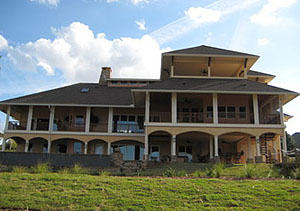

Vision House
Orlando, FL
 Photo: Roberto Carrion Testimonial from Roberto Carrion,
|
The Vision House is part of a group of demonstration projects around the country that showcase the National Association of Home Builder’s Model Green Building Guidelines.
Situated on Lake Apopka, just outside of Orlando, the home was constructed using plans to minimize the impact on the natural resources and environment surrounding it. Architects paid close attention to water and energy efficiency and incorporated features that take advantage of the local climate, such as high quality insulation and high performance windows and doors, providing a well-sealed building envelope. Right down to the landscaping, which utilizes native, drought resistant species to minimize the need for irrigation, this home is a perfect example of what “green” building really means.
Specific “green” features include:
- Cistern tanks used to collect rain and wastewater to be treated and reused for irrigation
- Low-flow plumbing fixtures and water efficient appliances
- Structural Insulated Panels (SIPs) – prefabricated foam panels that reduce time and expense used to build home
- Non-vented, semi-conditioned attic space
- Minimal use of east and west-facing windows
- Dehumidifiers used throughout HVAC planning
- Proper management of storm water runoff
- Low-emittance, double pane windows
- Use of recycled materials during construction
- Advanced foundations and house wrap materials to provide water-proof membrane and keep water out of house, eliminating risk of water damage, mold, health issues, etc.
- Low-volatile organic compounds (VOC) paints, adhesives, flooring, and rugs
- Natural wood obtained from certified forestry
- Indoor plants for natural air purification